PETRIFIED FOREST (Day 6 - part 4)
We left the Petrified Forest and hit the open road again. We stopped briefly at a gift shop outside the park for some souvenirs. While it's prohibited to collect samples in the national park, private lands are allowed to do what they wish with pieces found on their land.

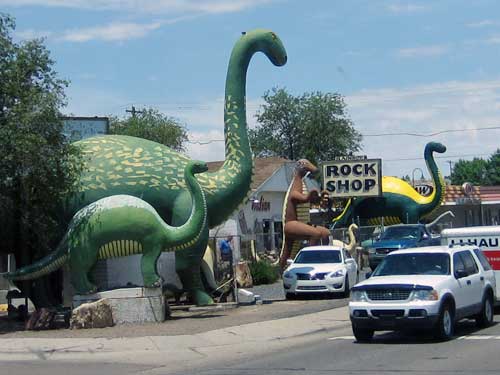
Passing through Holbrook

Classic cars and tall tents... the Wigwam Motel is a motel chain built during the 1930's and 40's. The rooms are built in the form of tipis, mistakenly referred to as wigwams.
Native Americans had different styles of housingbased on their lifestyle (nomadic hunters, permanent agricultural), location (desert, forest, arctic, swamp, etc) and climate. A tipi (or teepee) was a tent-like dwelling used by Plains tribes; cone-shaped wooden frame with a buffalo hide covering; designed to set up and break down quickly; transportable to follow the game herds; with few trees on the Great Plains, it was important to carry the long poles with them. A wigwam (also birchbark house) was a domed dwelling in the Northeast; woodland regions; wooden frames covered with sheets of birchbark; good for staying in the same place for months at a time; not portable but small and easy to build; could hold up to bad weather.

We stopped in Winslow for some lunch. It was bright and blue when we entered... but torrential rains when we left. The parking lot was flooding quickly as were the streets. Fortunately, as is the case with most desert storms, it left as quickly as it had arrived.
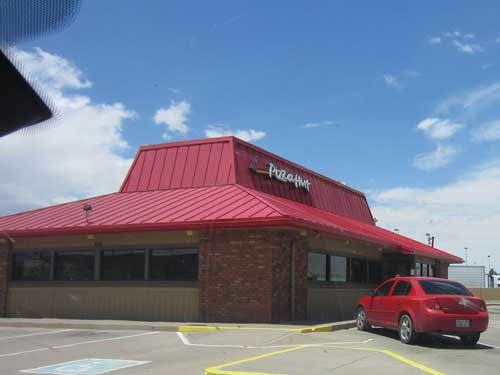
Blue skies upon entering...
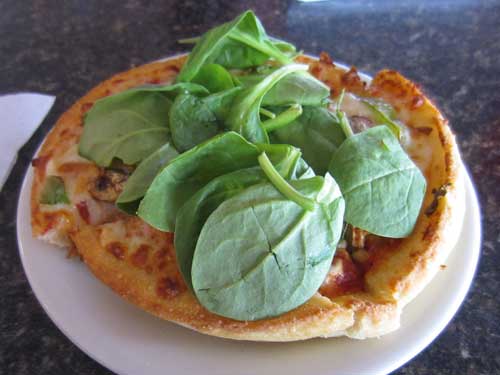
... a spot of lunch...

... and the weather as we left!
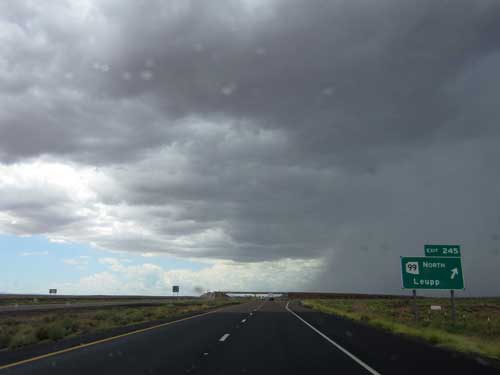
The storm recedes...

... to blue skies again.
We turned off the highway for a short detour to Meteor Crater.
About 50,000 years ago, a meteorite hit our planet with a speed of about 26,000 miles per hour. The impact caused the crater here in mere seconds... a 700 feet deep and 3/4 mile wide hole. Most of the meteorite either vaporized or melted. Only fragments that broke off before the impact survived.
Today, the crater is only 550 feet deep and a bit wider, thanks to thousands of years of erosion. The big reasons Meteor Crater is so important, however, are that it is not only the best-preserved but also the first-proven meteor crater on Earth.
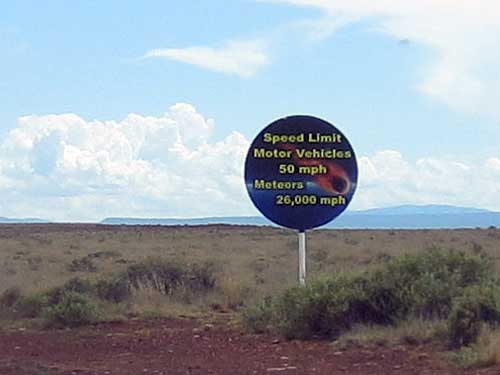

Since it was privately owned and not a national park (they had the chance to buy it but turned it down), they had the right to charge what they wanted. While definitely worth seeing once, I wasn't motivated to pay for a second time. So I waited about while Bill and Joanne enjoyed the giant hole in the ground.



We drove on, west towards Flagstaff. Again the heavy rains returned and a violent storm raged... briefly.

A storm looms in the distance... exactly where we need to go!
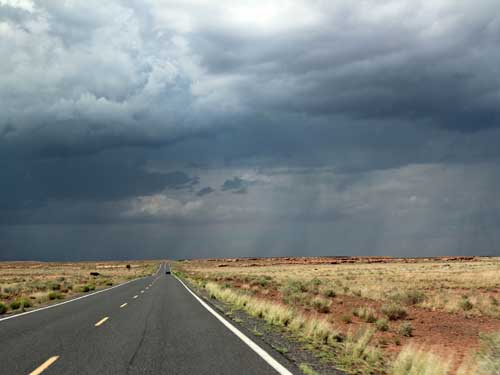
Entering the fury


As we passed Flagstaff, the clouds pulled back a bit, but only for a short while.

A glimpse of the San Francisco Peaks, a volcanic mountain range just north of the city

We turned south onto State Route 89A (SR 89A), which runs almost 84 miles down to Prescott. The road became a state highway in the late 1920's and passes through some beautiful scenery past Oak Creek Canyon and down into Sedona.

A curvy, twisty road is in our near future!


The rain returns for a bit.

The weather finally cleared once and for all as we reached the red rocks that Sedona is so famous for. Unfortunately we encountered the holiday traffic we had been warned about. It took quite a while to get into town, but at least there was plenty to look at!
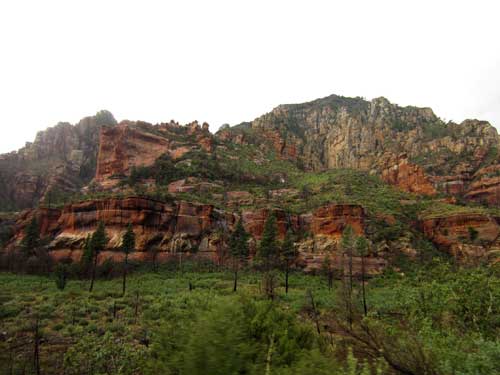
The rocks here are comprised of Schnebly Hill, Hermit and Supai layers. The bright red colors comes from iron oxide stains (rust, essentially).

Faulting helped the creek waters to break through the lava cap and carve the magnificent canyons.


Everyone apparently has the same idea as we do!
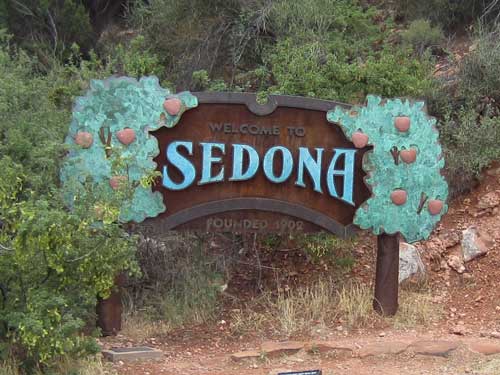
The first settler built his cabin in these areas in 1876. Then in 1901, a Pennsylvania Dutch man by the name of Theodore Schnebly moved into the area and purchased 80 acres. Hoping to get a post office established here, he submitted the name Schnebly Station. It was rejected because it was too long... so he tried again with his wife's name, Sedona. And so the town was officially created in 1902.


Eventually we arrived in the busy, charming downtown but we continued on to our hotel at the far end of the city.


The Sedona Real Inn & Suites was quite charming!

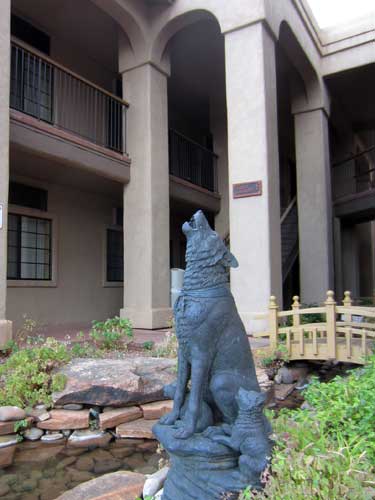


After pulling a very stubborn piece of tumbleweed out from under the car (that had probably been with us since the crater!), we headed out to dinner at the Barking Frog Grille.

This was far more effective than simply tumbling along!
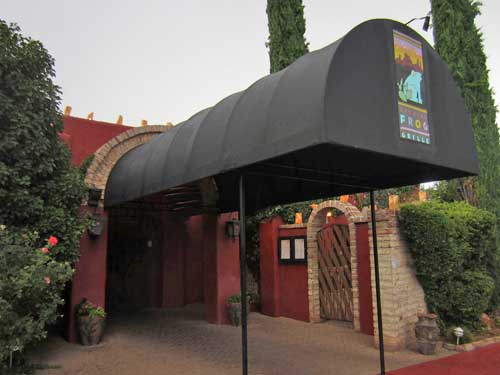
The Barking Frog Grille was originally constructed in the early 1990's. Apparently there really is a barking frog that lives on rocky slopes on mountains in southeastern Arizona. It is very elusive and only 'barks' for 2 - 3 nights following the first heavy monsoon of the summer thunderstorm season.

Waiting in the lobby. We were told it would be an hour wait but were seated within 5 minutes!

The Fireside Room

For some reason, it seems kind of wrong that they serve frog legs.

A wonderful mac & cheese with cornbread!

Cheers!!
return • continue

